A Sloths life cycle. A cath is a baby sloth.Middle aged sloths are in Sids range from the Original mov ie Ice Age. An adult soths is in its 30s or maybe 40s. Powered by Create your own unique website with customizable templates. Animal life cycles differ in the amount of time it takes from conception to the arrival of the infant animal, the gestation stage and the maturation phase. The time it takes for a growing sloth to reach sexual maturity depends on its species, but for the most part, three-toed sloths and two-toed sloths have similar life cycles.
Introduction
Despite their similar appearances, the rise of modern sloths is an interesting story of convergent evolution. There are two families of sloths, the two-toed sloth and the three-toed sloth, but there are six different species total. Two-toed sloths belong to the genus Choloepus and three-toed sloths belong to the genus Bradypus. Known for their slow movements and inefficient digestive systems, these creatures populate South American and Central American rainforests. Their diets mainly consist of leaves and fruits. All species of sloths spend their time in the rainforest canopy, spending between 15-20 hours a day sleeping, and only venturing to the floor in order to defecate.[1] The forest floor is full of predators that sloths mainly avoid by hiding in the forest canopy. Although both genera of sloths move little, the three-toed sloth moves an average of 5.4 hectares, while the two-toed sloth moves up to 140 hectares per day.[1] Their slow movements are due to their extremely slow metabolism, as they attempt to conserve energy by controlling movement speed. While they move slowly on land, they move significantly quicker in water. This ability frequently results in sloths swimming as opposed to walking on the forest floor. Sloths are solitary in nature, and spend most of their lives alone. The mating habits of sloths are unique, as they spend majority of their time in the trees, meaning they mate and give birth in the trees.[1] A female will call to attract a male, and the males that find her will fight in order to gain access to the female.
The evolution and microbiota of sloths are unique due to the animal's ancestors and the various fungi and bacteria that populate the coarse fur of the organism. The evolution of sloths is interesting because two and three toed sloths appear very closely related, but it has recently been suggested that they have vastly different ancestors, meaning that they evolved through convergent evolution. It was previously believed that these two groups of sloths diverged from the same ancestor, but this was a misconception in the science community. A better example of divergent evolution would be the evolution of dog breeds. Although the sloths belong to different families, they both have similar microbiota. The microbiota of sloths are the microorganisms that live within or on the sloth. The fur of the sloth is made of microorganisms that the sloth benefit from through a mutualistic relationship. The algae that grows within the fur of the sloth is essential for nutrients and digestion. It also promotes a mutualistic relationship between the sloth and moth species that are dependent on the sloth.
Genetics/Evolution
Two-toed and three-toed sloths subside on the same diet and belong to the same order, Pilosa. Phenotypically, they appear almost identical, with the main distinguishing feature being their number of toes. The hands and claws of the sloth have changed over time to resemble hooks that are used in order to hang from trees with limited effort. The ligaments and muscles of the sloth are not strained when hanging from the trees, another important evolutionary adaptation of the sloth.[2] These similar features would make them appear very closely related. However, these two sloths do not belong to the same family. Besides the difference between the number of toes each species has, they also differ in the number of vertebrae in their spines and several other morphological features. By examining the traits of the sloths like locomotion and suspensory posture,[3] it was discovered that the Bradypus and Choloepus species evolved through convergent evolution, which is where organisms with different ancestors or from different periods evolved similar phenotypes or traits.
Amino acid sequences also supported the new familial groupings of sloths. Researchers examined the collagen in fossils from extinct species.[4] This was done because DNA is normally unable to be extracted from fossils. The collagen was used to recreate the proteins of the extinct animals. Through this process, it was revealed that the two-toed sloth is grouped with the family Megalonychidae, which encompasses ground sloths, including the giant land sloth.[4] The three-toed sloths were grouped with the Bradypodidae family. This means that two and three-toed sloths are not closely related. Instead, they evolved to have similar phenotypes through convergent evolution.
Microbiome
Sloths have a mutualistic relationship with moths that live in their fur.[5] The algae that grows in sloth fur not only camouflages the sloths in the tree canopy, but also provides a source of nutrients for the sloths. The algae is rich in lipids and aids in digestion. This is essential for the sloth, because they only defecate once a week. If they do not have regular bowel movements, this increases the mass of the sloth, and can increase the risk of falling from the tree. Although the spines of sloths are flexible, falling from a high enough height can kill a sloth. Their predators are also abundant on the forest floor making any time spent on the ground dangerous. This means that the weekly trips to the ground to defecate are also dangerous for sloths. In order to survive, a short time spent defecating is necessary.
One of the main mysteries of sloths was their purpose in venturing to the forest floor to defecate. This has recently been explained by research about the mutualistic relationship that exists between sloths and moths. The amount of algae that grows in a sloth's fur is dependent on these moths. There are several species that colonize sloth fur, where they mate and live. By living in sloth fur, these moths avoid predators and have a steady food source, the algae. When the sloth climbs down the tree to defecate, a female moth will lay her eggs in the feces of the sloth. When the eggs hatch, the juvenile moths then return to a sloth's fur, where they grow and the cycle repeats. Recent research suggests that sloth moths increase the amount of nitrogen that is present in sloth fur.[5] The more abundant nitrogen is, the more the algae grows. The three-toed sloths appear to have a higher concentration of moths and algae, which may be due to the more limited movement of the three-toed sloth. The sloths are dependent on this algae, which is a proposed explanation for why they aid in the life cycle of the moths by climbing down the trees to defecate.
Conclusion

Two-toed and three-toed sloths are more distantly related than previously believed. Research suggests that they evolved from different families of extinct animals, meaning they evolved through convergent evolution. However, both of these sloths are similar in the cultivation of algae in their fur to promote digestion. The moths that live in their fur are also essential in the growth of algae. Both two and three-toed sloths have filled a similar niche in forest environments, despite their differing ancestry.
References
- ↑ 1.01.11.2Gardner, Alfred L. 'Sloth.' Encyclopædia Britannica, Encyclopædia Britannica, Inc., 13 June 2019, https://www.britannica.com/animal/sloth.
- ↑'The Sloth's Evolutionary Secret.' National Geographic, 3 Jan. 2012, https://www.nationalgeographic.com/science/phenomena/2012/01/03/the-sloths-evolutionary-secret/.
- ↑Nyakatura, J.A. 2012. The Convergent Evolution of Suspensory Posture and Locomotion in Tree Sloths. J Mammal Evol 19: 225. https://doi.org/10.1007/s10914-011-9174-x.
- ↑ 4.04.1Presslee, S., Slater, G.J., Pujos, F. et al. 2019. Palaeoproteomics resolves sloth relationships. Nat Ecol Evol 3, 1121–1130 doi:10.1038/s41559-019-0909-z.
- ↑ 5.05.1Pauli, J. N., Mendoza, J. E., Steffan, S. A., Carey, C. C., Weimer, P. J., & Peery, M. Z. (2014). A syndrome of mutualism reinforces the lifestyle of a sloth. Proceedings of the Royal Society B: Biological Sciences, 281(1778), 20133006. doi: 10.1098/rspb.2013.3006.
Edited by Cassandra Lis, student of Joan Slonczewski for BIOL 116 Information in Living Systems, 2019, Kenyon College.
Sloths are mammals found in South and Central America. They hang to the tree branches with their long claws. They survive on leaves. Their long claws make it difficult for them to walk on the ground. Hence, they spend a lot of time on trees.
There are two kinds of sloths; Two-toed and three-toed. They share most of the features but vary in size.
Table of Contents
- 11 Sloths Characteristics
Sloths Facts and Information
- Sloths are the slowest animals in the world.
- Algae grow on the fur of sloths. The green color of algae make sloths hide from predators in the trees.
- Sloths can climb only six to eight feet per minute.
- Sloths are wonderful swimmers. Sloths drop themselves into the water from the branches.
- Sloths do not shiver when it is cold as their body has only 25% muscle.
- The claws of sloths offer them protection against predators.
- The Scientific Name of the Sloths is Choloepus Hoffmanni
Sloths Diet
Sloths eat leaves which are hard to digest. The leaves are digested slowly in their four-part digestive system. A sloth takes a month to digest a meal of food. Their diet is not nutritious and they do not derive much energy from it.
Sloths are considered folivores as they rely on tender shoots, leaves and buds. Two-toed sloths have been found to eat small reptiles, birds and insects as per few documentations.
Sloths Habitat
Sloths are most commonly found in the rain forests of south and central America. They curl into a ball while sleeping. They also hang from the tree branches. Sloths are not known for activities.
They spend most of their time eating and sleeping. These leave trees only to swim. Sloths that have been kept captive sleep for fifteen to twenty hours per day. This leaves them with little time to indulge in social activities. Sloths prefer leading solo lives.
Sloths Appearance
Sloths have flat, short head, short snout, big eyes, long legs, tiny ears and curved claws. There are two species of sloths. These have either two or three claws. These have sad-looking eyes, stubby tails and roundish heads. Two toed sloths are bigger than the three toed ones. Three toed sloths seem as if they are smiling because of their facial coloring. Sloths can turn their head around because of the two extra vertebrae in the neck.


Behavior
A Sloths Life Cycle
Sloths spend a lot of time hanging from the branches of trees. They sleep, mate and eat in the trees. Their curved, strong claws help them in hanging from the branches of trees. Male sloths are shy, solitary animals. Female sloths indulge in little bit of socializing. They sleep entire day and are active during the night time. Sloths do not move until it is necessary. They defecate and urinate once a week and for this they come to the ground.
Sloths Lifespan
The life expectancy of a sloth varies based on the species. Most of the sloths live for 20 to 30 years. In captivity, there can survive for a longer time. The lifespan of a median sloth is 15 years.
Predators
Humans, the harpy eagle and jaguar are the main predators of sloths. Poachers and electrical lines were responsible for death of sloths in Costa Rica. A sloth can protect itself from camouflage and because of the slow movement. These features let them disappear in the canopy of the rainforest.
Sloths Breeding
Sloth mate and give birth to young ones in trees. Courting begins when a female sloth screams to inform the males in the area that she is ready for mating. Males put up a fight by hanging from the tree branches. They paw at other sloths to be the winner. Sloths just have one offspring at a time.
The gestation period is five to six months. The babies cling to their mothers for several weeks after their birth. They stay with their mothers for up to four years. The mating season is usually during the spring season. In South America, sloths mate during July-November. In Central America, the sloths mate during February-May.
Sloths Lifestyle
Sloths live in dense forests. They spend a lot of time in trees. They climb down once in a week to the base of the tree. They bury the feces in the vicinity of the trees they reside in. Their feces act as a wonderful fertilizer for the trees they reside in. This is because their stool breaks down quite easily.

Two-toed and three-toed sloths are more distantly related than previously believed. Research suggests that they evolved from different families of extinct animals, meaning they evolved through convergent evolution. However, both of these sloths are similar in the cultivation of algae in their fur to promote digestion. The moths that live in their fur are also essential in the growth of algae. Both two and three-toed sloths have filled a similar niche in forest environments, despite their differing ancestry.
References
- ↑ 1.01.11.2Gardner, Alfred L. 'Sloth.' Encyclopædia Britannica, Encyclopædia Britannica, Inc., 13 June 2019, https://www.britannica.com/animal/sloth.
- ↑'The Sloth's Evolutionary Secret.' National Geographic, 3 Jan. 2012, https://www.nationalgeographic.com/science/phenomena/2012/01/03/the-sloths-evolutionary-secret/.
- ↑Nyakatura, J.A. 2012. The Convergent Evolution of Suspensory Posture and Locomotion in Tree Sloths. J Mammal Evol 19: 225. https://doi.org/10.1007/s10914-011-9174-x.
- ↑ 4.04.1Presslee, S., Slater, G.J., Pujos, F. et al. 2019. Palaeoproteomics resolves sloth relationships. Nat Ecol Evol 3, 1121–1130 doi:10.1038/s41559-019-0909-z.
- ↑ 5.05.1Pauli, J. N., Mendoza, J. E., Steffan, S. A., Carey, C. C., Weimer, P. J., & Peery, M. Z. (2014). A syndrome of mutualism reinforces the lifestyle of a sloth. Proceedings of the Royal Society B: Biological Sciences, 281(1778), 20133006. doi: 10.1098/rspb.2013.3006.
Edited by Cassandra Lis, student of Joan Slonczewski for BIOL 116 Information in Living Systems, 2019, Kenyon College.
Sloths are mammals found in South and Central America. They hang to the tree branches with their long claws. They survive on leaves. Their long claws make it difficult for them to walk on the ground. Hence, they spend a lot of time on trees.
There are two kinds of sloths; Two-toed and three-toed. They share most of the features but vary in size.
Table of Contents
- 11 Sloths Characteristics
Sloths Facts and Information
- Sloths are the slowest animals in the world.
- Algae grow on the fur of sloths. The green color of algae make sloths hide from predators in the trees.
- Sloths can climb only six to eight feet per minute.
- Sloths are wonderful swimmers. Sloths drop themselves into the water from the branches.
- Sloths do not shiver when it is cold as their body has only 25% muscle.
- The claws of sloths offer them protection against predators.
- The Scientific Name of the Sloths is Choloepus Hoffmanni
Sloths Diet
Sloths eat leaves which are hard to digest. The leaves are digested slowly in their four-part digestive system. A sloth takes a month to digest a meal of food. Their diet is not nutritious and they do not derive much energy from it.
Sloths are considered folivores as they rely on tender shoots, leaves and buds. Two-toed sloths have been found to eat small reptiles, birds and insects as per few documentations.
Sloths Habitat
Sloths are most commonly found in the rain forests of south and central America. They curl into a ball while sleeping. They also hang from the tree branches. Sloths are not known for activities.
They spend most of their time eating and sleeping. These leave trees only to swim. Sloths that have been kept captive sleep for fifteen to twenty hours per day. This leaves them with little time to indulge in social activities. Sloths prefer leading solo lives.
Sloths Appearance
Sloths have flat, short head, short snout, big eyes, long legs, tiny ears and curved claws. There are two species of sloths. These have either two or three claws. These have sad-looking eyes, stubby tails and roundish heads. Two toed sloths are bigger than the three toed ones. Three toed sloths seem as if they are smiling because of their facial coloring. Sloths can turn their head around because of the two extra vertebrae in the neck.
Behavior
A Sloths Life Cycle
Sloths spend a lot of time hanging from the branches of trees. They sleep, mate and eat in the trees. Their curved, strong claws help them in hanging from the branches of trees. Male sloths are shy, solitary animals. Female sloths indulge in little bit of socializing. They sleep entire day and are active during the night time. Sloths do not move until it is necessary. They defecate and urinate once a week and for this they come to the ground.
Sloths Lifespan
The life expectancy of a sloth varies based on the species. Most of the sloths live for 20 to 30 years. In captivity, there can survive for a longer time. The lifespan of a median sloth is 15 years.
Predators
Humans, the harpy eagle and jaguar are the main predators of sloths. Poachers and electrical lines were responsible for death of sloths in Costa Rica. A sloth can protect itself from camouflage and because of the slow movement. These features let them disappear in the canopy of the rainforest.
Sloths Breeding
Sloth mate and give birth to young ones in trees. Courting begins when a female sloth screams to inform the males in the area that she is ready for mating. Males put up a fight by hanging from the tree branches. They paw at other sloths to be the winner. Sloths just have one offspring at a time.
The gestation period is five to six months. The babies cling to their mothers for several weeks after their birth. They stay with their mothers for up to four years. The mating season is usually during the spring season. In South America, sloths mate during July-November. In Central America, the sloths mate during February-May.
Sloths Lifestyle
Sloths live in dense forests. They spend a lot of time in trees. They climb down once in a week to the base of the tree. They bury the feces in the vicinity of the trees they reside in. Their feces act as a wonderful fertilizer for the trees they reside in. This is because their stool breaks down quite easily.
Images, Pics, Photos and Pictures of Sloths : Slots gokkasten.
Sloths Grooming
Sloths do not groom themselves. Casio 210 calculator hp. They have a dense coat of fur which grows algae. They have a greenish tinge during the rainy season because of the growth of algae. Sloths belly houses several micro bacteria for breaking down the food that they eat and thereby promote digestion.
The digestion process of a sloth is quite slow. It takes about a month for a slot to digest a meal. The metabolism of a sloth is very low. This is why the nutrients extracted from the sloths is slow and the low energy level probably the reason why they are sluggish.
Sloths Characteristics
- Sloths have greenish and thick brown coat of fur.
- They hand from trees with their claws.
- The only defense means for a sloth is its claw.
- A sloth that has been cornered tries to swipe the attackers to scare or wound them.
- Sloths move slowly and hence do not attract attention.
- They are vulnerable only during their visits to the ground that happens once in a week.
- Colonies of algae grow on sloths. This acts as a camouflage and source of nutrients when sloths try to lick their fur.
- In sloths, the hair grows in the opposite direction from other mammals. This is because they spend a lot of time with their legs above their bodies hanging from the tree branches. protection is offered to the sloths with their hair growing from extremities.
- Sloths are four legged animals
- Sloths land on the ground in upright position or else they spend most of the time up-side down hanging from tree branches
- Sloths are home to several creatures such as moths and beetles.
- Sloths are excellent swimmers.
- Sloths have multiple compartment stomachs.
Sloth Behavior
Related Posts
What Is A Sloths Life Cycle
- Aye Aye
The aye-aye is known as Daubentonia madagascariensis. It is a rodent like animal that can be found in Madagascar. Its features are similar to that of a rodent. The aye-aye…
- Red Panda
Red Pandas are popularly known as firefox, lesser panda, red bear cat and red cat bear. The size of these pandas is almost the same of a housecat, though their…

